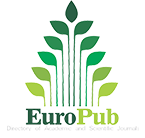Synthesis of thermal and physical properties of biodegradable hybrid nano fluid using two step method
Article ID: 3848
Vol 7, Issue 1, 2024
Vol 7, Issue 1, 2024
VIEWS - 2357 (Abstract)
Abstract
In the presence of green technology or biodegradable options, vegetable oils emerged as replacements for mineral oil as base oils due to their properties of high viscosity index, high flash point, low toxicity, low volatility, and high biodegradability. Nano fluids were a relatively new class of fluids that consisted of a base fluid with nano-sized particles (1–100 nm) suspended within them. The synthesis and characterization of biodegradable hybrid nano fluids and their combination with base materials were carried out in this paper, playing a vital role in machining operations. SiC and TiO2 were used as nano particles, with the base fluid being palm oil, and sodium dodecyl sulphate (SDS) was employed as a surfactant to maintain fluid stability. All samples were prepared in individual and hybrid modes, including palm oil as the base fluid without any emulsifier/surfactant, palm oil + SiC with nano particle concentrations of 0.1%, 0.2%, and 0.3% by volume, palm oil + TiO2 with nano particle concentrations of 0.1%, 0.2%, and 0.3% by volume, and palm oil + SiC + TiO2 with nano particle concentrations of 0.1%, 0.2%, and 0.3% by volume. The FTIR results showed that the SiC + palm oil and SiC + TiO2 + palm oil samples had better chemical composition and surface characterization as biodegradable hybrid nano fluids. The zeta potential values were observed to increase at volume concentrations of 1%, 2%, and 3%. Particularly, the biodegradable hybrid nano fluid samples (palm oil + 1% Vol. SiC + TiO2) and (palm oil + 2% Vol. SiC) demonstrated increased stability as well as enhanced physical, thermal, and rheological properties in machining applications.
Keywords
biodegradable hybrid nano fluid; FTIR; zeta potential; MQL; nano particle
Full Text:
PDFReferences
- Suresh S, Venkitaraj KP, Selvakumar P, et al. Synthesis of Al2O3–Cu/water hybrid nanofluids using two step method and its thermo physical properties. Colloids and Surfaces A: Physicochemical and Engineering Aspects 2011; 388(1–3): 41–48. doi: 10.1016/j.colsurfa.2011.08.005
- Taylor R, Coulombe S, Otanicar T, et al. Critical review of the novel applications and uses of nanofluids. In: Proceedings of ASME 2012 Third International Conference on Micro/Nanoscale Heat and Mass Transfer; 3–6 March 2012; Atlanta, Georgia, USA. pp. 219–234. doi: 10.1115/mnhmt2012-75189
- Yu W, Xie H. A review on nanofluids: Preparation, stability mechanisms, and applications. Journal of Nanomaterials 2012; 2012: 1–17. doi: 10.1155/2012/435873
- Abbasi SM, Rashidi A, Nemati A, et al. The effect of functionalisation method on the stability and the thermal conductivity of nanofluid hybrids of carbon nanotubes/gamma alumina. Ceramics International 2013; 39(4): 3885–3891. doi: 10.1016/j.ceramint.2012.10.232
- Sarkar J, Ghosh P, Adil A. A review on hybrid nanofluids: Recent research, development and applications. Renewable and Sustainable Energy Reviews 2015; 43: 164–177. doi: 10.1016/j.rser.2014.11.023
- Sidik NAC, Adamu IM, Jamil MM, et al. Recent progress on hybrid nanofluids in heat transfer applications: A comprehensive review. International Communications in Heat and Mass Transfer 2016; 78: 68–79. doi: 10.1016/j.icheatmasstransfer.2016.08.019
- Aberoumand S, Jafarimoghaddam A. Tungsten (III) oxide (WO3)–Silver/transformer oil hybrid nanofluid: Preparation, stability, thermal conductivity and dielectric strength. Alexandria Engineering Journal 2018; 57(1): 169–174. doi: 10.1016/j.aej.2016.11.003
- Akilu S, Sharma KV, Aklilu TB, et al. Temperature dependent properties of silicon carbide nanofluid in binary mixtures of glycerol-ethylene glycol. Procedia Engineering 2016; 148: 774–778. doi: 10.1016/j.proeng.2016.06.555
- Che Sidik NA, Mahmud Jamil M, Aziz Japar WMA, et al. A review on preparation methods, stability and applications of hybrid nanofluids. Renewable and Sustainable Energy Reviews 2017; 80: 1112–1122. doi: 10.1016/j.rser.2017.05.221
- Das PK. A review based on the effect and mechanism of thermal conductivity of normal nanofluids and hybrid nanofluids. Journal of Molecular Liquids 2017; 240: 420–446. doi: 10.1016/j.molliq.2017.05.071
- Sahid NSM, Rahman MM, et al. Experimental investigation on properties of hybrid nanofluids (TiO2 and ZnO) in water–ethylene glycol mixture. Journal of Mechanical Engineering and Sciences 2017; 11(4): 3087–3094. doi: 10.15282/jmes.11.4.2017.11.0277
- Asadi A, Asadi M, Rezaniakolaei A, et al. An experimental and theoretical investigation on heat transfer capability of Mg(OH)2/MWCNT-engine oil hybrid nano-lubricant adopted as a coolant and lubricant fluid. Applied Thermal Engineering 2018; 129: 577–586. doi: 10.1016/j.applthermaleng.2017.10.074
- Al-Waeli AHA, Chaichan MT, Kazem HA, et al. Evaluation and analysis of nanofluid and surfactant impact on photovoltaic-thermal systems. Case Studies in Thermal Engineering 2019; 13: 100392. doi: 10.1016/j.csite.2019.100392
- Dhar NR, Ahmed MT, Islam S. An experimental investigation on effect of minimum quantity lubrication in machining AISI 1040 steel. International Journal of Machine Tools and Manufacture 2007; 47(5): 748–753. doi: 10.1016/j.ijmachtools.2006.09.017
- Singh G, Sharma S, Seikh AH, et al. A novel study on the influence of graphene-based nanofluid concentrations on the response characteristics and surface-integrity of Hastelloy C-276 during minimum quantity lubrication. Heliyon 2023; 9(9): e19175. doi: 10.1016/j.heliyon.2023.e19175
- Singh G, Aggarwal V, Singh S, et al. Experimental investigation and performance optimization during machining of Hastelloy C-276 using green lubricants. Materials 2022; 15(15): 5451. doi: 10.3390/ma15155451
- Dhinesh Kumar D, Valan Arasu A. A comprehensive review of preparation, characterization, properties and stability of hybrid nanofluids. Renewable and Sustainable Energy Reviews 2018; 81: 1669–1689. doi: 10.1016/j.rser.2017.05.257
DOI: https://doi.org/10.24294/ace.v7i1.3848
Refbacks
- There are currently no refbacks.

This work is licensed under a Creative Commons Attribution-NonCommercial 4.0 International License.









